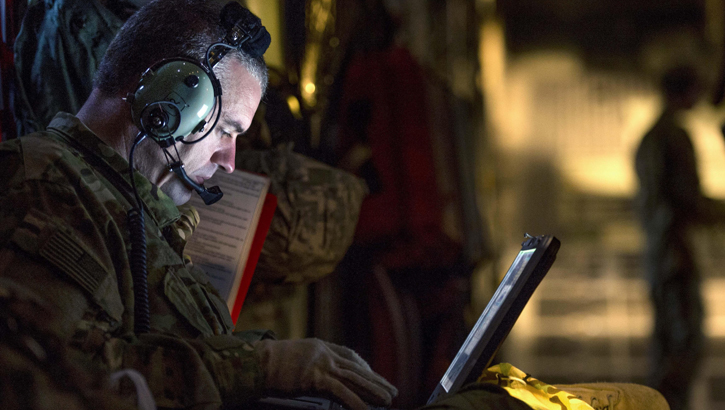
How DHA monitors the spread of health outbreaks

The Armed Forces Health Surveillance Branch (AFHSB) is the central epidemiologic resource for the U.S. Armed Forces, conducting medical surveillance to protect those who serve our nation in uniform and allies who are critical to our national security interests. AFHSB provides timely, relevant, actionable and comprehensive health surveillance information to promote, maintain, and enhance the health of military and military-associated populations. (U.S. Air Force photo by Tech. Sgt. Nathan Lipscomb)
The Defense Health Agency works as a combat support agency to the military services and Military Health System with epidemiology data that improves the health and readiness of all service members and their beneficiaries.
Here’s how the Armed Forces Health Surveillance Branch is supporting the coronavirus (COVID-19) outbreak.
How We Monitor
How We Monitor
COVID-19 is a reportable medical event (RME) in the military. RMEs are medical conditions, such as measles, which when found in individuals, potentially impact larger groups of people. The tri-service reporting system for RMEs is the Disease Reporting System internet (DRSi). The Alert and Response Ops group within the Integrated Biosurveillance section of the AFHSB at DHA tracks and reports information about COVID-19 from DRSi daily.
AFHSB also conducts daily surveillance using the Electronic Surveillance System for the Early Notification of Community-based Epidemics (ESSENCE). The ESSENCE team developed a dashboard that monitors information from the electronic medical record to detect clinical activity suspicious or diagnostic of COVID-19 in beneficiary populations at all military treatment facilities. It also alerts public health professionals about potential disease outbreaks and epidemics so appropriate countermeasures can be taken.
“The COVID-19 time-series graphs from ESSENCE are shared by combatant commands through the Joint Staff,” said Juan Ubiera, Chief, Integrated Biosurveillance. “AFHSB has also created a mailbox for questions related to the COVID-19 dashboard.”
The division’s Epidemiology and Analysis (E&A) section uses the Defense Medical Surveillance System to analyze medical encounter and other health care data, including data from outsourced care, to track disease trends. This allows E&A to produce regular reports, such as the weekly DoD Consolidated Influenza Surveillance Report.
“We are reviewing guidance from the U.S. Centers for Disease Control and Prevention and the World Health Organization to determine the feasibility and value of producing a weekly COVID-19 report that will add to the reports produced by the Integrated Biosurveillance team in the unlikely event that COVID-19 becomes widespread,” said Navy Cmdr. (Dr.) Shawn Clausen, AFHSB’s Epidemiology and Analysis Chief.
COVID-19 Lab Testing Kits
COVID-19 Lab Testing Kits
AFHSB Global Emerging Infections Surveillance (GEIS) section is coordinating efforts with DoD and interagency partners to ensure DoD network labs can globally support detection and characterization of COVID-19 cases. GEIS currently funds ongoing surveillance efforts of animal markets on the Vietnam-China border and provides laboratory support for detection of respiratory diseases throughout a global network.
GEIS has supported COVID-19 activities through coordination of guidance as well as reagent procurement and distribution of surveillance testing material across the Military Health System network.
As of March 5, the United States Army Medical Research Institute of Infectious Diseases (USAMRIID) had received and performed validation of surveillance reagents and observed no issues with performance.
Additionally, the reagents have been shipped to GEIS-supported laboratories including Naval Medical Research Units (NAMRU) in the Middle East, Southeast Asia, and South America; Armed Forces Research Institute of Medical Sciences (AFRIMS); U.S. Army Medical Research Directorate-Africa (including associated test sites in Uganda and Tanzania); USMRD – Georgia; Landstuhl Regional Medical Center (LRMC), U.S. Naval Health Research Center; and U.S. Air Force School of Aerospace Medicine. Currently, all GEIS-supported laboratories, with the exception of NAMRU-3 sites in Egypt and Jordan, have received the test kits and are ready to provide surveillance support as requested.
These tests are molecular-based, COVID-19 detection assays that enable sample analysis and results in 4-6 hours. In addition, optimized Next-Generation Sequencing (NGS) assays are evaluated by the GEIS NGS consortium partners and shared with partner laboratories when available. Through this support, GEIS-funded laboratories in Southeast Asia and across the network continue to provide information and analytical laboratory support to the geographic combatant commands and countries in their region.
“Testing kits specifically procured through U.S. Army Medical Research Institute of Infectious Diseases (USAMRIID) are intended for surveillance use in DoD laboratories. The primers and probes, and protocols, for the USAMRIID testing kits are the same as the CDC Emergency Use Authorization assay; however, DoD labs are only to use the testing kits for nonclinical/surveillance testing,” said Navy Cmdr. (Dr.) Mark Scheckelhoff, who leads the Respiratory Infections focus area for AFHSB's Global Emerging Infections Surveillance section.
International Health Surveillance
Along with research, AFHSB concluded a NATO health surveillance collaboration meeting with international force health protection leaders March 11 at AFHSB headquarters in Silver Spring, Maryland.
“We recognize that there is a lack of robust information sharing for military partners in NATO,” said O. Sean Friendly, AFHSB’s chief of operations and administration. “Through this ‘Smart Defense’ process, we are trying to close that gap with a shared health surveillance.”
The purpose of the two-part meetings was to develop a concept for a shared international mapping capability, similar to that of DoD’s Health Surveillance Explorer.
“If this capability were already in place, we would be able to see how this recent health outbreak of COVID-19 is impacting the movement of military troops in our NATO partnership,” said Friendly. “An international map would allow us to see how public health outbreaks impact the movement, mission, and ability of our troops to be healthy.”





















.png)









No hay comentarios:
Publicar un comentario